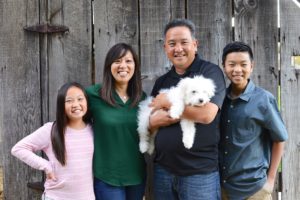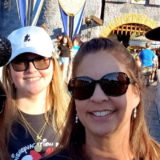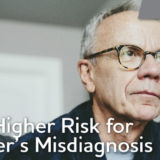Deanna walks so other caregivers also receive support
Deanna Wong of Walnut Creek first heard of the Alzheimer’s Association when she was helping to care for her father, David. She saw firsthand how much the education and support services helped her and her mother.
Deanna and her family have been participating in the East Bay Walk to End Alzheimer’s for five years. Since 2015, Deanna has been a member of the Walk planning committee and is currently the Marketing and Outreach chair. She recently shared her story with us.
The first signs
It all started with my mom casually sharing with me that my dad was changing, and his behavior was “different” than it used to be. It was just little things.

Instead of paying at the cash register he would open up his wallet so my mom could pull out his money. Instead of ordering at a restaurant, he would have the same thing my mom was having. But these little things eventually started to add up to a bigger picture.
My father was a proud man and was amazingly adept at hiding his symptoms. With him, there was never an acknowledgement that there was anything wrong, and certainly no openness to seeking diagnosis or treatment.
We were unable to seek treatment without his consent. This made everything extraordinarily hard as we watched him decline and struggle. To say that we were unprepared for our journey with Alzheimer’s is an understatement.
Concern for Mom, the primary caregiver
As my father’s cognitive skills declined more, he became more confused, dependent, and needy. It became unbearable for my mom as she struggled to shoulder the burden of 24/7 caregiving.
Mom lived in a constant state of anxiety and stress. She became depressed at her circumstances. I began worrying more about my mom’s well-being than my father’s.
Finding support
The turning point for us came after, in a move of desperation, I convinced my mom to attend an Alzheimer’s Association support group with me. Coming from an Asian culture, talking about our feelings to a group of strangers was the last thing we wanted to do, but our desperation for help was enough motivation to try.

As we went around the circle sharing, I heard the stories of the people around me and recognized my family’s story in theirs. These people were struggling with so many of the same issues that we were experiencing.
By the time it was our turn to share, we found ourselves crying and sharing the burdens that we had been silently shouldering. We learned so much that day, as the group members shared recommendations on programs and services we should explore. It gave us hope that things could get better.
Reaching out, accessing resources
The best thing was that we learned how to ask for help and not carry the burden alone. We called the Alzheimer’s Association 24/7 Helpline when we had situations that we had no idea how to deal with.
We reached out to resources to find relief for my mom: first to explore an adult day center, and eventually to find a memory care facility. Coming to the decision to move my dad out of his home was one of the most stressful things I have ever experienced. My dad received wonderful care from the staff, and I know that this decision ultimately saved my mom.
Why I volunteer for the Walk
Why do I volunteer with the Walk to End Alzheimer’s committee? Because I hope that by sharing my experience I can help others the same way that others helped us. Alzheimer’s can be a very isolating disease for caregivers.

It’s important for people to know that there is a community out there who understands what they are going through. I Walk because I truly believe in the programs that the Alzheimer’s Association provides. I am living proof that they work.
I know there will be an end of Alzheimer’s disease, but until that day, we need to support programs for families, caregivers, and those living with the disease today. Please join me in this fight for a world without Alzheimer’s.
You can join Deanna in participating in the East Bay Walk to End Alzheimers or find a Walk near you.
Learn more:

















